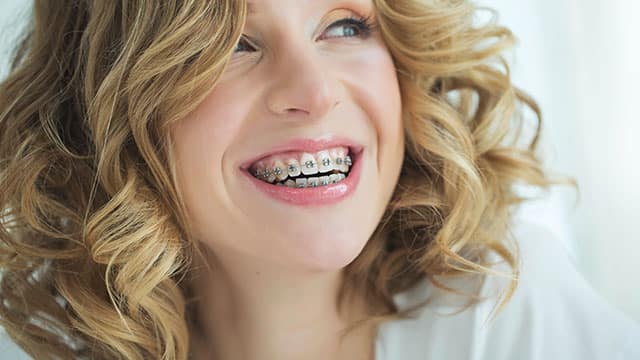What Are Lingual Braces?
Lingual braces work similarly to traditional braces, using brackets, wires, and sometimes plastic bands to move the teeth. However, the brackets are placed on the inside of the teeth instead of the outside. The word "lingual" in dentistry means "toward the tongue." This way, the braces can only be seen if you open your mouth extra wide.
Advantages of Lingual Braces
- Visibility. Lingual braces are probably the hardest to spot of all teeth straightening methods. Many patients can smile, eat, and talk with no one noticing.
- Permanence. Because the brackets are securely attached to your teeth, minimal patient participation is required. Your only responsibility is attending appointments every six to eight weeks.
- Results. Sometimes braces do a better job at straightening extremely crooked or overcrowded teeth. Braces give the orthodontist complete control over your teeth, so minor adjustments can be made to perfect your smile.
Disadvantages of Lingual Braces
- Comfortability. Some people find lingual braces uncomfortable while talking and eating because the wires cause friction on the tongue. The braces can also crowd your tongue, making it harder to swallow. Some people report a slight lisp.
- Oral care. Just like traditional braces, oral hygiene becomes more of a challenge. It will take more time to clean around the brackets and wires. You will also need to skip sticky foods that will be hard to clean off or harder foods that could break the wires and brackets.
- Cost and availability. Not all orthodontists offer lingual braces, so you will need to research to find a provider. Additionally, putting on lingual braces takes longer. Both of these factors can drive up the cost. Authority Dental reports the cost range between $5,000 and $13,000.
What Are Clear Aligners?
Orthodontic treatment with clear aligners involves a series of clear plastic "trays" precisely fitted for your teeth, such as Invisalign®. You wear each set of trays for a set amount of time to move teeth gently before advancing to the next set.
Advantages of Clear Aligners
- Removability. One of the biggest advantages of clear aligners is that you can take them out when needed. This means easily removing them to eat, take a photo, or brush your teeth. It also makes it easier to keep up your oral hygiene routine.
- Speed. Though clear aligners work more gently to move teeth into place, they typically take the same amount of time as regular braces. Most treatment plans take between 12 and 18 months.
- Cost. Clear aligners also cost similarly to traditional braces so that you can get the same results more discreetly. Authority Dental reports the average cost of clear aligners between $1,100 and $9,500, while traditional braces usually cost between $1,800 and $8,500.
Disadvantages of Clear Aligners
- Visibility. Because clear aligners are "clear," they provide a much more discreet way of straightening teeth than metal braces. However, you can still see the retainers when close enough. Thankfully, you can remove them for your most important moments — like a photo or a job interview.
- Responsibility. With clear aligners, you hold more responsibility for your treatment. This means making sure you wear the aligners for the recommended amount each day — usually 20 to 22 hours — and switch the trays at the right time. It also means taking extra care not to accidentally lose the aligners when you take them out.
Colgate is offering orthodontic aligners in the Dallas, Texas area and expanding. If you are interested, please visit colgatealigners.com to learn more.
Other Considerations
Unfortunately, lingual braces and clear aligners are not an option for everybody. When the patient's teeth are severely overcrowded or overlapping or experience complex bite issues, the orthodontist might recommend traditional braces as the preferred treatment. Every mouth is different, so talk to your dentist or orthodontist about your options, what will work best, and which will give you the fastest results.
No matter which treatment you choose, remember to practice good oral hygiene. Brush twice a day for two minutes, clean between teeth with floss or another interdental device, and make regular trips to your dentist's office for exams.
Both lingual braces and clear aligners provide great options for those looking for more aligned teeth. Talk to your orthodontist or dentist about each option, consider the pros and cons, and start your journey to a straighter smile.
This article is intended to promote understanding of and knowledge about general oral health topics. It is not intended to be a substitute for professional advice, diagnosis or treatment. Always seek the advice of your dentist or other qualified healthcare provider with any questions you may have regarding a medical condition or treatment.
ORAL HEALTH QUIZ
What's behind your smile?
Take our Oral Health assessment to get the most from your oral care routine
ORAL HEALTH QUIZ
What's behind your smile?
Take our Oral Health assessment to get the most from your oral care routine















